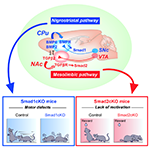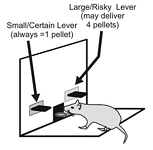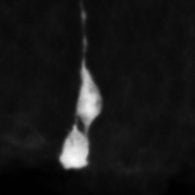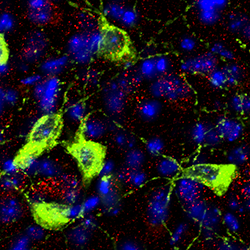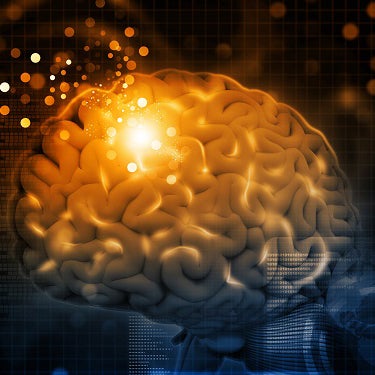Neuro Topics - Dopamine
SEARCH OTHER RESEARCH AREAS
February 8, 2024
The Uchida lab used a genetically encoded glutamate sensor to examine the pattern of glutamate inputs to dopamine neurons in mice. Combining the results with existing knowledge about GABA signaling to these neurons, they gained a new understanding of how these two neurotransmitters collaborate to bring dopamine neurons the information they need to encode reward prediction error (RPE)—the difference between expected and received rewards.
Original article in: Neuron >
October 6, 2023
Akiko Terauchi and Hisashi Umemori share new research that identified the pathway-specific signals that establish functionally segregated dopaminergic synaptic connections in the mammalian brain. The findings may provide strategies to treat pathway-specific disease symptoms in diseases like Parkinson's disease, schizophrenia, and depression, by targeting the pathway-specific molecular signals.
Original article in: Cell >
May 4, 2022
HMS News article on new research from Pascal Kaeser and colleagues, first author Changliang Liu, identifying a new mechanism that underlies dopamine release in the brain.
Original article in: Science >
February 25, 2022
Allison E. Hamilos from the lab of John Assad shares new insights into the role of dopaminergic signaling in modulating the moment-to-moment probability of planned movement.
Original article in: eLife >
February 24, 2022
Harvard Gazette article on a recent panel sponsored by the Harvard Mind Brain Behavior Initiative featuring Kirk R. Daffner, Daniel L. Schacter, and Susanna C. Siegel using the plot of the film Memento to discuss memory, amnesia, and personality.
Original article in: eLife >
August 30, 2021
Beth Israel Deaconess Medical Center press release on new research from the lab of Mark Andermann, first author Stephen X. Zhang, uncovering the precise hypothalamic neurons that regulate the drive to engage in mating behaviors in mice.
Original article in: Nature >
August 25, 2021
Graduate student Ya'el Courtney (lab of Maria Lehtinen, Boston Children's Hospital) shares her story about navigating a difficult adolescence, facing financial challenges, and her journey to graduate school and neuroscience research.
Original article in: Nature >
August 24, 2021
John Mikhael and Sam Gershman argue that dopamine gates the influence of contextual information when making decisions. They show that this view captures dopamine’s seemingly conflicting roles in impulsivity, risk preferences, and the exploration-exploitation trade-off.
Original article in: Neuropsychopharmacology >
Disease Characteristics of Dopaminergic Neurons in Neurodevelopmental and Neuropsychiatric Disorders
July 20, 2021
Maria Sundberg shares new research from the lab of Mustafa Sahin on the role of a small piece of chromosome 16, called the 16p11.2 locus, in disease phenotypes of dopaminergic neurons. The team identified that RhoA pathway activation led to network dysfunction in 16p11.2 deletion neurons. Its inhibitor, Rhosin, rescued the hyperactivity of these neuronal networks. In the future, the RhoA pathway and its inhibitors may serve as potential therapeutic targets.
Original article in: Nature Communications >
January 25, 2021
Suk Joon Lee shares new research from the Sabatini lab on the use of fluorescence lifetime photometry to monitor activity in the neurons of a mouse performing a reward-based learning task. Their findings provide in-vivo evidence for the presumed connection between the neurotransmitter dopamine and the enzyme protein kinase A (PKA), linked to synaptic plasticity, in the basal ganglia.
Original article in: Nature >
January 20, 2021
Miguel Turrero García and Corey Harwell share new research exploring how chromatin modifications in neural stem cells can shape the formation of complex circuits in the cerebral cortex.
Original article in: Nature >
January 13, 2021
Round up of awards and honors earned by the HBI community.
Original article in: Nature >
January 5, 2021
Krissy Lyon describes a new study from the lab of Susan Dymecki, examining how serotonin-producing neurons and dopamine interact in the brainstem to modulate mouse behaviors, and how this might differ in males versus females.
Original article in: eNeuro >
December 17, 2020
How do we perceive the reachable world? Emilie Josephs shares a recent study from the lab of Talia Konkle suggesting different brain representations for processing near-scale environments, far-scale environments, and single objects.
Original article in: PNAS >
October 1, 2018
Has your research provided a breathtaking image of the nervous system that you’d love to share with the world? Send it to HBI! You could win a $200 cash prize and have your work displayed online and/or on the walls of Harvard’s science buildings.
Original article in: PNAS >
September 27, 2018
Postdoctoral fellows Carolyn Elya (lab of Benjamin de Bivort) and Shan Meltzer (lab of David Ginty) were awarded 2018 HHMI Hanna Gray Fellowships.
Original article in: PNAS >
September 27, 2018
A new study from the labs of Staci Bilbo and colleagues reveals role of microglia in adolescent development different for males, females.
Original article in: Nature Communications >


